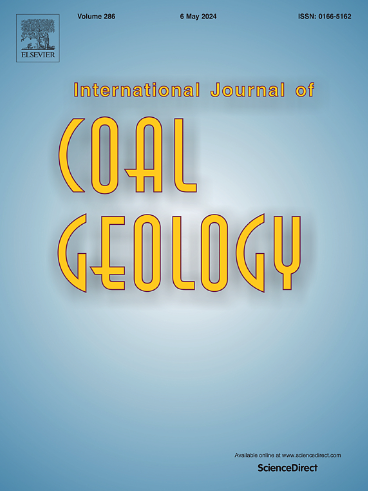温度对NaClO刺激过程中煤显微组分溶解和基质蚀变的影响:来自显微镜和Micro-CT的观察
IF 5.7
2区 工程技术
Q2 ENERGY & FUELS
引用次数: 0
摘要
氧化增产已成为提高煤层天然气采收率的一种有希望的补充方法,与影响矿物成分的酸增产相比,氧化增产更直接地针对煤中的有机质。然而,不同煤显微组分亚型对氧化剂的反应性,特别是在储层条件下,仍然知之甚少。本研究采用次氯酸钠(NaClO)研究了澳大利亚Bowen盆地烟煤样品在不同温度条件下的显微反应性和基质蚀变。显微和显微ct分析显示,较高的温度显著增强了显微组分的溶解。观察到的反应活性顺序为:半麻质组→镜质组→镜质组→丝质组,镜质组内的胶泥质反应活性明显高于胶泥质。这些差异应归因于芳香性、官能团组成和孔隙结构的差异。显微ct结果显示,半丝质组溶解深度为300 ~ 500 μm,丝质组溶解深度为~ 100 μm,镜质组溶解深度为50 ~ 150 μm。煤基质为细粒非均质寄主,具有较强的方向依赖性,沿水平(顺层)方向孔隙和裂缝发育显著增强。在60℃时,反应深度可达850 μm,孔隙明显扩大,特别是在30 ~ 50 μm范围内。混合显微组分区反应锋面较镜质组富集区深,突出了显微组分非均质性对氧化剂渗透的影响。该研究强调了氧化诱导的基质蚀变的程度、方向性和有效性受显微成分和层理结构的影响。这些发现为优化氧化增产策略以提高非均质煤储层的采收率提供了重要见解。本文章由计算机程序翻译,如有差异,请以英文原文为准。
Effect of temperature on coal maceral dissolution and matrix alteration during NaClO stimulation: Insights from microscopy and Micro-CT
Oxidant stimulation has emerged as a promising supplementary approach to enhance gas recovery from coal seams, targeting coal organic matter more directly than acid stimulation, which affects mineral components. However, the reactivity of different coal maceral subtypes to oxidants, particularly under reservoir conditions, remains poorly understood. In this study, sodium hypochlorite (NaClO) was used to investigate the maceral-specific reactivity and matrix alteration of bituminous coal samples from the Bowen Basin, Australia, under varying temperature conditions. Microscopic and Micro-CT analyses revealed that higher temperatures significantly enhanced maceral dissolution. The observed reactivity followed the order: semifusinite > vitrinite > fusinite, with collodetrinite within vitrinite displaying notably higher reactivity than collotelinite. These divergences should be ascribed to the differences in aromaticity, functional group composition, and pore structure. Micro-CT results revealed maceral-dependent dissolution depths, ranging from 300 to 500 μm for semifusinite, ∼100 μm for fusinite, and 50–150 μm for vitrinite bands. As a fine-grained heterogeneous host to telovitrinite macerals and other detrital components, coal matrix exhibited strong alteration in directional dependence, with significantly enhanced pore and fracture development along the horizontal (bedding plane) direction. At 60 °C, the reaction depth reached up to 850 μm, accompanied by substantial pore enlargement, particularly within the 30–50 μm range. Mixed maceral zones showed deeper reaction fronts than vitrinite-rich areas, emphasizing the influence of maceral heterogeneity on oxidant penetration. This study highlights that both maceral composition and bedding structure critically govern the extent, directionality, and effectiveness of oxidant-induced matrix alteration. These findings provide important insights into optimizing oxidant stimulation strategies for improved gas recovery in heterogeneous coal reservoirs.
求助全文
通过发布文献求助,成功后即可免费获取论文全文。
去求助
来源期刊

International Journal of Coal Geology
工程技术-地球科学综合
CiteScore
11.00
自引率
14.30%
发文量
145
审稿时长
38 days
期刊介绍:
The International Journal of Coal Geology deals with fundamental and applied aspects of the geology and petrology of coal, oil/gas source rocks and shale gas resources. The journal aims to advance the exploration, exploitation and utilization of these resources, and to stimulate environmental awareness as well as advancement of engineering for effective resource management.
 求助内容:
求助内容: 应助结果提醒方式:
应助结果提醒方式:


